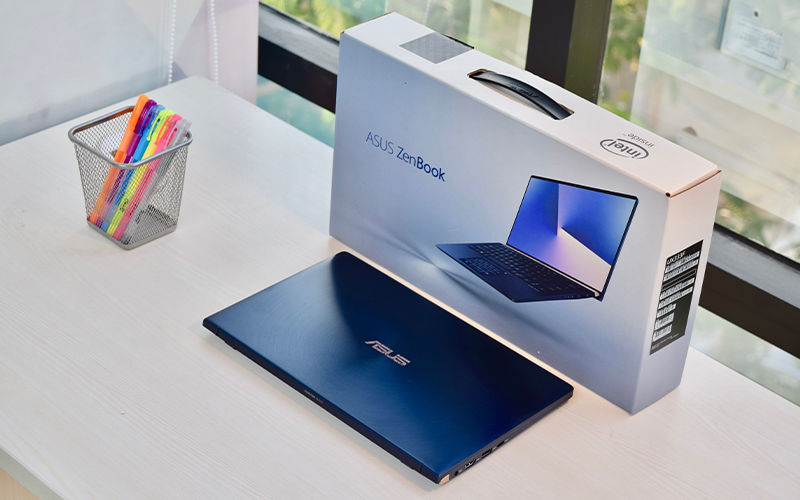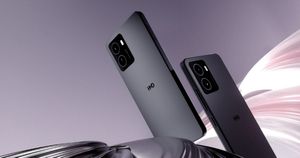
The era of thin and lite laptops started with the launch of the Apple MacBook Air. Back then, Windows laptops were neither compact nor sturdy enough compared to the ones from Apple. However, over the years, Windows laptop manufacturers have worked hard to make their laptops compact and robust. Asus is one of those brands. Its ZenBook lineup of laptops is known for having a small size and excellent build quality.
Asus ZenBook 13 UX333FN
Every year, Asus launches a new ZenBook which is smaller than its predecessor in spite of featuring the same screen size. The Asus ZenBook 13 UX333 is the latest addition to the ZenBook lineup. It comes in five variants that are priced between INR 71,990 and INR 99,990. The one we are reviewing today is the top of the line variant.
This new laptop surpasses even the Apple MacBook Air in terms of compactness. Moreover, the ZenBook 13 has all the essential physical ports to avoid #DongleLife. You can also get the ZenBook 13 with a dedicated GPU. The Asus ZenBook 13 looks like the perfect MacBook Air competitor and a compact Windows laptop everyone has been waiting for but is it? Let us have a look in our review.
[P_REVIEW post_id=146515 visual=’full’]
In the Box
- Asus ZenBook 13 UX333FN
- 65 Watt Charger
- Cleaning Cloth
- Manuals
Design and Build Quality
The Asus ZenBook 13 is the smallest laptop in the world with a 13-inch display. I think that sentence alone is enough to describe how compact it is. The laptop weighs just 1.06Kgs. The small footprint and the lightweight design make the ZenBook 13 easy to carry around. What is surprising is that Asus has managed to make the laptop compact while packing all the essential physical ports. The same cannot be said for most other thin and light laptops in the market. Take the new MacBook Air and HP Spectre 13 for example. They only have USB Type-C ports. There is no microSD card slot, USB Type-A port, or HDMI port on offer, even though they are comparatively larger than the ZenBook 13. Considering this, I think Asus did a great job here.
The Asus ZenBook 13 also performs exceptionally well in terms of build quality. The laptop offers a premium feel when you hold it in hand. There are no creaking sounds from the body. The hinge feels very stable, and the opening and closing actions are very smooth. Speaking of the hinge, it is what Asus calls as ErgoLift hinge. Basically, it lifts the base of the laptop when you open the lid. According to Asus, this helps in cooling, typing, and sound quality, and Asus is right. The lifted base paves the way for the cool air to enter the chassis thus improving the thermal performance of the laptop. Because the bottom part is lifted, the keyboard gets slightly inclined, which helps in typing as well. And how does it assist in improving the sound quality? Well, the speakers are located at the bottom of the laptop. When you open the lid, the speakers get slightly raised above the ground. Due to this, the sound bounces off from the surface, which in turn offers a louder volume. The ErgoLift hinge is a brilliant idea, and it provides a host of advantages. The ZenBook 13 also come with MIL-STD-810G certification for drop and shock resistance.
Coming to the appearance of the device, the ZenBook 13 looks modern and premium. There is a concentric circle design on top of the lid. This gives the laptop an industrial look. However, this concentric circle finish is a fingerprint magnet. It attracts fingerprints even to the slightest touch, and when the lid gets prints on it, it looks ugly. Asus should have coated the top with an oleophobic layer to safeguard it against fingerprints. This is one flaw with the design. However, it is not a major one. You can live with it. Keeping this issue aside, the Asus ZenBook 13 has one of the best designs, and build qualities among all the laptops in its price range.
Display and Sound
The Asus ZenBook 13 has a 13.3-inch IPS LCD with Full HD resolution. It has a jaw-dropping 95% screen-to-body ratio, which is higher than every other consumer laptop that is on sale. These thin bezels add a lot more appeal to the display. The quality of the display is great as well. It has enough brightness for indoor usage, great viewing angles, and excellent color reproduction. However, the screen is very reflective. Hence, you might have a hard time using it outdoors.
Asus has placed the speakers at the bottom of the laptop. The ErgoLift hinge lifts the speakers above the surface to produce a better sound. However, I was skeptical that this technique would not work when you keep the laptop on your lap. I thought it would muffle the sound. Fortunately, that didn’t happen. The speakers sound fine even when you keep the laptop on an uneven surface. The speakers have crisp highs and decent low-frequency sound reproduction. However, they are not loud enough. The sound quality is better than what you get on most similarly priced Windows laptops, but it is still no match for the sound quality from the Apple MacBook Air.
Keyboard and Trackpad
The ZenBook 13 comes with a white backlit keyboard. The keyboard is compact due to the small size of the laptop. Hence, typing on it feels a bit cramped. People with large hands will have a problem with this keyboard. Another issue with the keyboard is that the shift key on the right side is small as the arrow key takes up space there. I didn’t have a problem with it because I don’t use right side shift key much, but for those who do, it could be an issue. The keys, however, feel good to type as they have a decent amount of travel and tactile feedback.
The trackpad is one of the exciting parts of the ZenBook 13. It is not any ordinary trackpad; it has a number pad built into it that lights up in blue when you activate it by long-pressing the button on the right corner of the trackpad. Although the number pad is a nifty feature, I don’t think it is very useful, but hey, Asus has gone through the struggle to put it there, it deserves some credit. The trackpad itself is fantastic. One of the best I have used so far on a Windows laptop. It is on par with the one on the Dell XPS 13. Well, apart from the fact that this one is a tad smaller. The trackpad has a silky-smooth surface, and it registers the touch swiftly and accurately.
Webcam and Connectivity
In spite of having a thin bezel above the display, Asus has somehow managed to put an HD camera in there, and that too a Windows Hello based IR camera. I am glad to see that the Asus ZenBook 13 has a conventional webcam placement, unlike many other compact laptops which do not. The camera quality itself is average. The Windows Hello based unlocking, however, is blazing fast and accurate.
In terms of wired connectivity, the ZenBook 13 has all the physical ports that most users would want. There is one USB 3.1 Gen 2 Type-A port, one USB 3.1 Gen 2 Type-C port, an HDMI port, and a charging port on the left, and a USB 2.0 Type-A port, a microSD card slot, and a 3.5mm audio jack on the right. Asus could have used a USB 3.0 port on the right side instead of a USB 2.0 port, but hey, what ZenBook 13 offers is a lot better than most other thin and light laptops in the market.
Moving to the wireless connectivity, the ZenBook 13 has a dual-band gigabit-class Wi-Fi a/b/g/n/ac, and Bluetooth v5.0. Initially, I thought the gigabit-class Wi-Fi would make a difference only if you have a blazing fast internet connection — for example, a 1Gbps network. However, to my surprise, the gigabit-class Wi-Fi on the ZenBook 13 offered better performance than the non-gigabit Wi-Fi on my Lenovo Yoga 530 even with 200Mbps internet connection. I ran an internet speed test on my Lenovo Yoga 530 and the ZenBook 13 using Speedtest. The Yoga 530 churned out 150Mbps speed, whereas, the ZenBook 13 clocked around 175Mbps. Apart from this, the download speed for any file that I downloaded via the internet was faster on the gigabit-class Wi-Fi equipped ZenBook 13 as opposed to that on the Lenovo Yoga 530.
Performance
The Asus ZenBook 13 comes in five variants. The one we are reviewing today has an Intel Core i7-8565U processor, 2GB MX150 graphics, 8GB of 2133MHz DDR3 RAM, and 512GB PCIe storage.
Let’s start with the processor. The Core i7-8565U is the latest chipset from Intel and the best you could get in a 13-inch laptop. At first, I was skeptical that the processor would thermal throttle under heavy loads due to the thin chassis of the ZenBook 13, but it didn’t. I put the laptop to stress test with the help of AIDA64, and the processor held on its 1.8GHz base clock speed without breaking a sweat. Even with 100% load, the processor never crossed 70 degrees Celsius mark. What is even better is that the surface temperature was always kept below 45 degrees Celsius, making sure that the user should not feel the laptop too warm to use even under heavy workloads. Asus has done some exceptionally well thermal management here. We ran a couple of CPU benchmarks, have a look at them.
Coming to the graphics, the Nvidia GeForce MX150 is undoubtedly a significant upgrade over the integrated HD 620 graphics. However, it can only handle lite games such as Counter-Strike, PUBG, and Fortnite. In these games, the GPU manages to push around a healthy 60 frames per second at native resolution and graphics set to medium. The MX150 is however not sufficient to play graphics intensive AAA game titles. Yes, we tried, but it didn’t go well. Even with the lowest possible resolution and graphics settings, we could hardly get 30 frames per second in games like Assassin’s Creed, Shadow of the Tomb Raider, and the GTA 5. This is the best you could get out of a thin and light laptop. Therefore, I wouldn’t complain. Here are the GPU benchmarks.
The Asus ZenBook 13 gets 8GB of RAM regardless of the variant you choose. There is no 16GB RAM variant on offer. If that wasn’t disappointing enough, have a look at this, users can’t even upgrade the memory because it is soldered to the motherboard. Yes, 8GB of RAM is usually enough for most day-to-day tasks and multitasking, but the use-case varies from user to user. Some people might need more RAM. The lack of upgradability and the lack of a 16GB RAM variant is quite disappointing for me.
Moving on to the storage, the ZenBook 13 features an M.2 NVMe drive with x2 PCIe lanes. The storage drive is soldered to the motherboard as well. Therefore, there is no scope for upgradability. Fortunately, users can at least opt for a 512GB variant if they want with the Core i7 model, which I think will be enough for most users. The NVMe drive itself has a blazingly fast performance. Thanks to the fast storage chip, the ZenBook 13 boots up in a matter of seconds, applications launch swiftly, and the file transfers within the system are speedy. Here are the storage drive benchmarks.
Battery
Asus promises a 14-hour battery backup with the ZenBook 13. The laptop packs a 50Wh 3-cell lithium-polymer battery. During the review period, I usually got around eight to nine hours of battery backup. My usage mostly included using the laptop with 80% display brightness, and working on five different applications that include EM Client, Slack, Google Chrome, Microsoft Word, and Adobe Photoshop. Although the battery backup figures are far off from what Asus is promising, they are still excellent. The battery backup is indeed one of the best among the Windows laptops. For those who are looking for a Windows laptop with a long battery backup in a compact form factor, the Asus ZenBook 13 is the one for them. Charging the device from 0 to 100 percent takes around two and a half hours, which I think is quite decent.
Verdict
The Asus ZenBook 13 has an extremely compact design without compromising on physical ports, a great build quality, an excellent display, and a long battery backup, making it great for every traveler. What’s more? It even performs great and can double up as a casual gaming laptop for e-sport titles. And all of this comes with a reasonable price tag. Not only the ZenBook 13 is the best compact Windows laptop right now, but it even throws a sucker punch at the new MacBook Air in terms of features, performance, and value. If you have been eyeing the ZenBook 13, don’t think twice. Just buy it.










































